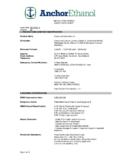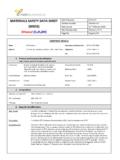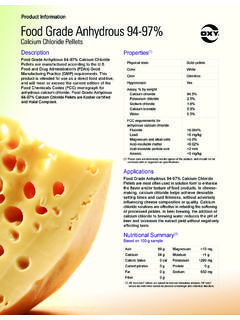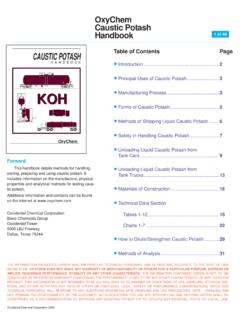Transcription of New Zealand Data Sheet - Medsafe
1 Page 1 of 8 New Zealand data Sheet Name of Medicine One- alpha alfacalcidol Presentation One- alpha capsules g. White oval capsules with a joining seam around the middle and 8 mm in length. One- alpha capsules g. Smooth, brown oval capsules of 8 mm in length. One- alpha drops g/ml is a clear colourless solution. Uses Action Alfacalcidol (1alpha-OHD3) is rapidly converted in the liver to 1,25-dihydroxyvitamin D3 (1,25-(OH)2D3), the metabolite of vitamin D which acts as a regulator of calcium and phosphate homeostasis. Impaired endogenous production of 1,25-dihydroxyvitamin D3 by the kidneys appears to contribute to the disturbances in mineral metabolism found in several disorders, including renal bone disease, hypoparathyroidism, and vitamin D-dependent rickets.
2 These disorders, which require high doses of vitamin D for their correction will respond to small doses of One- alpha . As compared to vitamin D, the main advantage of One- alpha is more rapid onset and offset of action. This allows a more accurate titration of dosage and decreases the risk of prolonged hypercalcaemia. Pharmacokinetics Serum levels of 1,25-(OH)2 D3 peak approximately 12 hours after a single dose of One- alpha and remain at measurable levels for at least 48 hours. The effect of 1 g of One- alpha on calcium absorption has been observed within 6 hours and was maximal at 24 hours. The biological half-life is approximately 35 hours.
3 Indications Disease caused by disturbances in the calcium metabolism in consequence of reduced endogenous production of 1,25-dihydroxyvitamin D3. Renal osteodystrophy. Postoperative or idiopathic hypoparathyroidism. Pseudohypoparathyrodism. As an adjunct to the management of tertiary hyperparathyroidism. Vitamin D-resistant rickets or osteomalacia. Vitamin D-dependent rickets, neonatal hypocalcaemia or rickets. Malabsorption of calcium. Malabsorptive and nutritional rickets and osteomalacia. Postmenopausal osteoporosis. Page 2 of 8 Dosage and Administration Initial dose: Adults and children above 20 kg body weight: 1 g daily Children under 20 kg body weight: g/kg/day Neonates: g/kg/day Dosage in the elderly: g/day It is important to adjust dosage thereafter according to the biochemical responses and to avoid hypercalcaemia.
4 Indices of response include levels of serum calcium, alkaline phosphatase, parathyroid hormone, urinary calcium excretion as well as radiographic and histological investigations. Patients with marked bone disease (other than those with renal failure) may tolerate higher doses without developing hypercalcaemia. However, failure of the serum calcium to rise promptly in osteomalacia patients does not necessarily mean that a higher dose is required since calcium from increased intestinal calcium absorption may be incorporated into demineralized bone. Most patients will respond to doses between 1 and 3 g daily. The dose requirements generally decrease in patients with bone disease when there is biochemical or radiographic evidence of bone healing and in hypoparathyroid patients after normal serum calcium levels have been attained.
5 Maintenance doses are generally in the range of to 1 g daily. In patients with osteoporosis receiving One- alpha , the recommended dosage for One- alpha for postmenopausal osteoporosis patients is 1 g daily. The dose should be titrated according to the individual needs. Calcium supplementation should not be required if the normal dietary intake is in region of 1500 mg per day. However, many postmenopausal patients have dietary intake as little as 600 mg per day and calcium supplementation of 1 g per day could be required. Patients currently taking barbiturates or other anticonvulsants may need larger doses of One- alpha to produce the desired effect.
6 Contraindications Hypercalcaemia. Hypersensitivity to alfacalcidol or any of the excipients listed in Further Information . Warnings and Precautions During the treatment with One- alpha , serum calcium and phosphate levels should be monitored regularly. PTH, alkaline phosphatase and calcium x phosphate should be monitored as clinically needed. Plasma calcium levels should be measured at weekly to monthly intervals depending on the progress of the patient. Frequent estimations are necessary in the early stages of treatment (particularly when the plasma calcium is already relatively high) and later when there is evidence of bone healing. Page 3 of 8 Hypercalcaemia might appear in patients treated with One- alpha .
7 For this reason, patients should be informed about the clinical symptoms connected with hypercalcaemia. Signs of hypercalcaemia are anorexia, fatigue, nausea and vomiting, constipation or diarrhoea, polyuria, sweating, headache, polydipsia, hypertension, somnolence and vertigo. Hypercalcaemia can be rapidly corrected by stopping treatment until plasma calcium levels return to normal (in about one week). One- alpha may then be restarted at a reduced dose (hald the previous dose) with monitoring of risk of hypercalcaemia depends on such factors as the degree of any mineralization defect, renal function, and the dose of One- alpha . Hypercalcaemia will occur when there is biochemical evidence of bone healing ( a return towards normal in the level of plasma alkaline phosphatase) and the dose of 1alpha-OHD3 is not reduced appropriately.
8 Prolonged hypercalcaemia should be avoided as it may aggravate arteriosclerosis, cardiac valve sclerosis or nephrolithiasis. Transient or even long-lasting deterioration of kidney function has been observed. One- alpha should also be used with caution in patients with calcification of pulmonary tissue as this may result in cardiac disease. In patients with renal bone disease or severely reduced renal function One- alpha should be given in combination with a phosphate binding agent to prevent hyperphosphataemia and potential metastatic calcification. One- alpha should be used with caution in patients with granulomatous diseases such as sarcoidosis where the sensitivity to vitamin D is increased due to increased hydroxylation activity.
9 Concurrent use of digitalis glycosides in the presence of hypercalcaemia due to vitamin D administration increases the potential for cardiac arrhythmias. One- alpha capsules contain sesame oil as an excipient. Sesame oil may rarely cause severe allergic reactions. One- alpha drops contain: - 14% v/v ethanol (alcohol) as an excipient, that is, up to 340 mg ethanol per dose (corresponding to 6 g of alphacalcidol), equivalent to 9 mL beer or mL wine. The alcohol content may be harmful to those suffering from alcoholism. The alcohol content must be taken into account in pregnant or breastfeeding women, in children and in high-risk groups such as patients with liver disease or epilepsy.
10 - Sorbitol as an excipient. Patients with rare hereditary problems of fructose intolerance should not take this medicine. - Methyl parahydroxybenzoate (also known as methyl hydroxybenzoate) as an excipient. Methyl parahydroxybenzoate may cause allergic reactions (possibly delayed). - Macrogolglycerol hydroxystearate as an excipient. Macrogolglycerol hydroxystearate may cause stomach upset and diarrhoea. Effects on ability to drive and use machines Alfacalcidol has no or negligible direct influence on the ability to drive and use Page 4 of 8 machines. However, the patient should be informed that dizziness may occur during treatment and take this into account while driving or using machines.
















